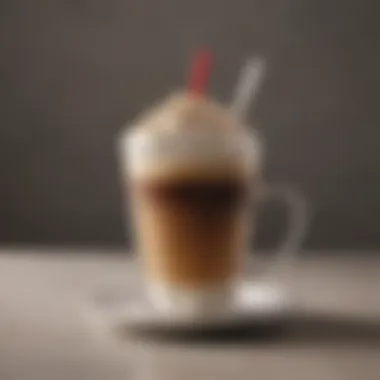The Versatility of Coffee Cups with Lids and Straws


Intro
In our fast-paced world, the coffee cup has transcended its humble beginnings. No longer merely a vessel for hot beverages, coffee cups with lids and straws have emerged as multifunctional items. They serve not just as containers but as a reflection of modern consumer behavior, blending functionality with style.
These cups come in various designs and materials, tailored for busy individuals seeking convenience. The evolution of these everyday items speaks volumes about our needs and preferences. Today, this article will delve into their practical benefits, the materials used in their construction, and their impact on how we consume coffee.
Coffee cups with lids and straws cater to a new generation of consumers who prioritize efficiency without sacrificing enjoyment. Understanding their significance can enhance your coffee-drinking experience and inspire myriad choices.
Design Evolution
The design of coffee cups has shifted dramatically over the decades. Initially, cups were simple porcelain or glass vessels, primarily found in cafes. Today, manufacturers are embracing innovative designs that not only preserve temperature but also address consumer demands for mobility.
Lids provide a seal that reduces spills. Straws enable easy sipping, enhancing the experience, especially when enjoying iced or blended coffee drinks. These features have become essential for those on the go, reflecting lifestyle changes driven by convenience.
Material choices also play a crucial role. Plastic, stainless steel, and biodegradable options are available. Each material offers distinct advantages in terms of insulation, durability, and environmental impact. This diversity means consumers can find the perfect cup that aligns with individual values and lifestyle needs.
Functional Benefits
The benefits of using coffee cups with lids and straws are significant. To start with:
- Spill Prevention: Lids minimize the risk of spills, making them ideal for travel.
- Temperature Regulation: Insulated designs keep beverages hot or cold longer.
- Convenient Consumption: Straws allow for an easy sipping experience, particularly with layered drinks.
- Sustainability: Many brands are now focusing on eco-friendly materials, encouraging responsible consumption.
These functional benefits add layers of convenience for busy individuals. No more worrying about coffee stains on clothing or scalded fingers from hot cups.
Consumer Behavior Impact
The availability of coffee cups with lids and straws has notably influenced consumer habits. The increased use of takeout coffee options reflects a broader trend where people favor convenience over traditional in-store consumption.
Moreover, these cups have become fashion statements. Customized designs or branded cups often signify personal style. As a result, they persist as popular items among diverse demographics.
The unique selling proposition of these cups suggests that the experience of coffee consumption can enhance daily activities. As we explore further, it becomes clear how these variations continue to serve the growing demand for efficiency and enjoyment in our coffee rituals.
Culmination
Foreword to Coffee Cups with Lids and Straws
In our fast-paced world, convenience has become a vital aspect of daily living. Coffee cups with lids and straws exemplify this convenience, providing an efficient method for on-the-go consumption. Many individuals, including busy professionals, parents, and anyone who enjoys their caffeinated beverages, find these cups invaluable.
The functionality offered by these coffee cups cannot be overstated. They are designed to prevent spills, retain heat, and allow for easy sipping while commuting or running errands. This makes them particularly appealing to people who wish to enjoy their drinks without the hassle of mess and waste of time.
Moreover, the design features of modern coffee cups cater to various needs and preferences. Materials such as plastic, glass, and stainless steel each provide unique advantages. For example, stainless steel cups are known for their durability and heat retention, while plastic options are lightweight and often designed for single use.
Considerations around health and safety are also significant. The integration of lids and straws can promote hygiene, especially in a time when many are more conscious of cleanliness. This also highlights the importance of material safety, as consumers become increasingly aware of what their drinking vessels contain.
Ultimately, coffee cups with lids and straws serve a dual purpose: they combine practicality with style. As consumer habits shift towards a preference for products that enhance their lifestyles, the relevance of these coffee cups is more pronounced than ever. Exploring the versatility of these items not only uncovers their practicality but also their evolution and impact on our daily coffee-drinking rituals.
Historical Evolution of Coffee Cups
The historical evolution of coffee cups is an essential aspect of understanding the current landscape of coffee drinking. Over the years, coffee cups have transitioned from simple vessels to multifunctional designs that cater to diverse consumer needs. This evolution reflects changing lifestyles, environment awareness, and technological advancements. Recognizing these shifts offers valuable insight into why coffee cups with lids and straws have become so popular today.
Traditional Coffee Drinking Vessel


Initially, coffee was consumed from various traditional vessels. In regions like the Middle East and Europe, these early coffee drinking vessels were often made from ceramics or glass. They served not only as containers but also as cultural artifacts. Just as tea houses in Japan focus on the aesthetic of the tea serving vessels, coffee mugs began to reflect social status and artistry.
These traditional cups were not designed with lids or straws. As a result, drinkers often faced challenges with spills or cooling of their beverages. They did offer great taste, but convenience was lacking. The enjoyment of coffee was tied to the experience, both visual and tactile. However, this led to an emerging demand for practical solutions, setting the stage for market innovations in coffee cup design.
The Rise of Disposable Cups
The advent of the disposable coffee cup marked a significant turning point in coffee consumption. Introduced in the mid-20th century, these cups provided a new level of convenience, allowing consumers to enjoy their beverages on the go. By eliminating the need for washing and maintaining reusable cups, disposable cups became an appealing option for fast-paced lifestyles.
The rise of disposable cups also coincided with an increase in coffee shop culture. Established brands began to adopt these cups as a core part of their service. However, this convenience brought environmental concerns to the forefront. Many disposable options were not recyclable or biodegradable, leading to substantial waste. This has prompted recent interest in sustainable disposable and reusable design options.
Innovations in Design
Innovations in coffee cup design have profoundly impacted usability and sustainability. Modern coffee cups come equipped with various features that enhance the drinking experience. Here are some notable advancements:
- Lid Mechanisms: Lids designed for spill resistance are now commonplace. Various styles, such as screw-on, snap-on, and push technology, cater to different consumer preferences.
- Materials Selection: Manufacturers have increased the use of alternative materials, from biodegradable plastics to stainless steel and glass, reflecting a growing awareness of environmental impact.
- Straw Integration: The addition of built-in or removable straws enhances drinkability, especially for iced coffee or blended beverages. This has become especially popular among younger consumers who prefer versatility in their drinking habits.
As these innovations continue to evolve, coffee cups with lids and straws represent a convergence of tradition and modern demand. They embody a practical solution for today’s coffee aficionados while addressing wider environmental concerns. This historical context sets the groundwork for discussing the design features and user experience associated with modern coffee cups.
Design Features of Modern Coffee Cups
The design features of modern coffee cups with lids and straws play a crucial role in their utility and appeal. As consumers seek convenience and style, these design elements significantly enhance the overall experience of using these cups. They cater to the demands of busy lives, making these vessels more than just holders for beverages. Instead, they become essential accessories for daily routines, combining functionality with aesthetics.
Materials Used
Plastic
Plastic is a prevalent choice for coffee cups with lids and straws due to its lightweight and durable nature. It is often more affordable compared to other materials, making it accessible for mass production. Its key characteristic is versatility; plastic cups come in a multitude of shapes and sizes. This adaptability allows for creative designs that can highlight branding or seasonal themes. However, while convenient, plastic cups can also raise concerns regarding environmental sustainability. They may not always be recyclable, and their contribution to landfill waste is significant.
Glass
Glass coffee cups often appeal to those who prefer a classic and sophisticated look. The clarity of glass allows for an appealing visual presentation of the beverage inside. A striking aspect of glass coffee cups is their ability to retain heat well, keeping drinks warm longer. This makes them ideal for hot beverages. Nonetheless, they can be heavier and more prone to breaking, making them less suitable for on-the-go consumption. Moreover, glass can be more expensive, which may limit its usage in casual settings.
Stainless Steel
Stainless steel coffee cups offer a robust option that is both stylish and functional. A prominent advantage of stainless steel is its superior insulation properties, helping to maintain the temperature of hot or cold drinks for extended periods. This feature makes them popular for outdoor enthusiasts or individuals who commute frequently. Additionally, stainless steel is usually more environmentally friendly than plastic, as it is reusable and recyclable. However, the initial cost may be higher than other options, which can be a limiting factor in widespread adoption.
Lid Mechanisms
Screw-on Lids
Screw-on lids provide a secure closure, minimizing the risk of spills. The primary advantage of this mechanism is its reliability; it ensures that the contents are contained, even during vigorous movement. This feature is particularly beneficial for individuals who transport their drinks in bags or car cup holders. However, one downside is that they can be cumbersome to put on and take off, especially for quick sips.
Snap-on Lids
Snap-on lids are designed for ease of use. They allow for quick access to the drink, making them a favored choice for busy consumers. The key benefit of snap-on lids is their simplicity; they can be removed easily and placed back without hassle. However, they may not offer the same level of spill protection as screw-on lids, which could be a drawback for those who prioritize security in their beverage containers.
Push Technology
Lids equipped with push technology represent a modern advancement in coffee cup design. They are engineered for convenience, allowing users to access their beverages with a simple push of a button. This mechanism can be particularly appealing for those who drink coffee while driving or multitasking. A notable advantage is that push technology often integrates ergonomic design, making it comfortable to use. Nonetheless, these lids can be susceptible to mechanical failure, which might deter some users.
Straw Integration


Built-in Straws
Built-in straws add a layer of convenience, allowing for easy sipping while reducing the need for additional components. This design simplifies the consumer experience, making it straightforward to enjoy cold drinks. They are often seen in reusable models, promoting sustainability. The downside, however, is that they might not be suitable for all types of beverages, especially thicker drinks that may clog the straw.
Removable Straws
Removable straws offer flexibility, enabling consumers to replace them as needed. This aspect is beneficial for those who prioritize hygiene, allowing for regular cleaning or replacement of worn straws. Additionally, they can be used with various cup designs and styles, enhancing the versatility of the product. On the contrary, lost straws may become a common issue, leading to incomplete drink systems.
In summary, understanding the design features of modern coffee cups with lids and straws is essential for both consumers and manufacturers. They not only define functionality but also shape user experiences and preferences.
Functionality and User Experience
In the landscape of modern consumer products, the functionality and user experience of coffee cups with lids and straws play a crucial role. These features are not merely conveniences; they address specific needs and preferences of users. Understanding how these aspects influence both daily activities and broader trends in consumer behavior is essential.
The design of coffee cups with lids and straws promotes a seamless experience for users. The ability to consume beverages quickly in various contexts adds to its appeal. Moreover, user experience extends beyond convenience to include safety concerns and health considerations.
Convenience for On-the-Go Consumption
For busy individuals, coffee cups with lids and straws provide an excellent solution for on-the-go consumption. They allow users to enjoy their favorite drinks without the usual fuss associated with open cups. This is especially beneficial for commuters or anyone navigating a hectic lifestyle. The integrated straw offers a simple way to sip beverages while multitasking, minimizing the risk of spills.
Safety Concerns
Safety concerns are paramount when evaluating the effectiveness of coffee cups with lids and straws. There are two primary areas of focus: spill resistance and heat retention.
Spill Resistance
Spill resistance is a defining characteristic of modern coffee cups. Manufacturers often utilize specific lid designs that securely seal the drink, significantly reducing the chances of accidental spillage. This feature is especially important for people carrying drinks during travel.
A spill-resistant coffee cup can be a beneficial choice because it encourages users to remain mobile, knowing their drink is secure. The design often includes a silicone rim or locking mechanism which enhances durability against drops. By minimizing messes, this feature elevates the user experience while safeguarding environments like cars or workspaces from beverage-related accidents.
Heat Retention
Heat retention is another important aspect of coffee cups with lids and straws. This ensures that beverages maintain their desired temperature for extended periods. Many cups employ double-wall insulation or use materials like stainless steel to enhance heat retention.
For consumers who savor their coffee hot, excellent heat retention is a popular choice. Users can enjoy their drink without rushing, which can enhance pleasure and satisfaction. However, it is vital to note that prolonged heat exposure can make the cup's exterior hot to touch, raising concerns about burns.
Health Considerations
Health considerations associated with coffee cups are increasingly coming to the forefront. Two specific areas warrant attention: material safety and cleaning and hygiene.
Material Safety
Material safety is critical when choosing a coffee cup. Consumers are becoming more aware of the potential health risks associated with certain plastics and chemicals in drinkware. Quality cups utilize materials free from harmful substances, ensuring safety for everyday use. Popular choices include BPA-free plastics and food-grade stainless steel.
Selecting materials that adhere to safety guidelines offers reassurance to users about their health. Notably, this aspect fosters trust in brands that prioritize consumer well-being.
Cleaning and Hygiene
Cleaning and hygiene are essential for maintaining health standards when using coffee cups. It is important to choose cups that can be easily cleaned, particularly those with removable components.
Easy-to-clean products are beneficial as they help eliminate bacteria buildup. Some designs promote dishwasher safety, while other options may require manual cleaning. Establishing proper hygiene practices enhances the consumer experience, supporting a sense of safety and health consciousness.


Ensuring both functional and user-friendly design features has made coffee cups with lids and straws indispensable in modern society.
Environmental Impact of Coffee Cups
The discussion surrounding the environmental impact of coffee cups cannot be overstated. It raises significant awareness about the consequences of our daily choices and serves as a critical element of this article. Coffee cups, especially disposable ones, contribute a noteworthy portion to global waste. As modern consumers prioritize convenience, it becomes essential to explore sustainable practices. This section will delve into how different materials perform in these facets and the potential for sustainable alternatives to transform our coffee-drinking habits.
Recyclability of Different Materials
The recyclability of coffee cup materials plays an important role in evaluating their environmental impact. Common materials include paper, plastic, and metal. Paper cups often contain a plastic lining that hinders recycling efforts, making them a challenge for waste management systems. Plastics, notably polystyrene, also face similar issues, as they often end up in landfills due to limited recycling capabilities. In contrast, stainless steel cups offer the benefit of complete recyclability, contributing positively to reducing waste and reinforcing the principles of a circular economy.
Sustainable Alternatives
Bamboo Cups
Bamboo cups present a viable alternative to traditional disposable options. The key characteristic of bamboo is its rapid growth, making it a renewable resource. Bamboo cups not only reduce waste but are also biodegradable. A notable unique feature of bamboo cups is their ability to retain warmth, which enhances the overall coffee-drinking experience. However, it’s important to note that while bamboo is sustainable, the manufacturing process can sometimes involve additives that may not be environmentally friendly. Hence, choosing responsibly sourced bamboo is crucial in ensuring its benefits.
Reusable Options
Reusable options have emerged as a significant part of the eco-conscious lifestyle. With materials ranging from stainless steel to silicone, these cups are designed to maintain the functionality of traditional coffee cups while reducing waste. A major advantage of reusable options is their long lifespan, which means fewer cups are disposed of each year, helping to minimize environmental harm. However, it's essential to clean these cups properly to maintain hygiene standards. Failure to do so could lead to a buildup of harmful bacteria, counteracting the primary purpose of choosing reusable over single-use cups.
Choosing sustainable coffee cups is essential for protecting our environment. Every small decision counts toward creating a more eco-friendly world.
Consumer Preferences and Trends
Understanding consumer preferences and identifying trends in the coffee cups with lids and straws market is essential. These elements shape product design, marketing strategies, and ultimately how these products are used in daily life. As people seek convenience and functionality, brands must adapt to meet evolving demands. This section will dissect key aspects of market analysis and the influence of branding.
Market Analysis
The coffee cup market, especially those featuring lids and straws, has experienced considerable growth. This stems from an increasing consumer base that values convenience. Busy lifestyles lead individuals to look for easy solutions that contribute to on-the-go coffee consumption. According to recent studies, consumers show a preference for reusable and eco-friendly options, underlining a shift towards sustainability.
Retail analysts observe that practical features drive consumer choices. For example, spill-resistant lids and integrated straws enhance the usability of these cups while attracting attention to their design and material composition. This preference for functionality tends to reflect broader trends in consumer habits, demonstrating that customers are becoming more discerning.
Furthermore, a mix of aesthetics and practicality in modern coffee cups contributes to their appeal. Sleek designs paired with vibrant colors resonate with a diverse audience. Key demographics, including millennials and Gen Z, often prioritize aesthetics alongside functional attributes. They seek products that reflect their personal values, including environmental consciousness. This aspect underlies the growing trend of eco-friendly materials like bamboo or stainless steel used in coffee cups.
Influence of Branding
Branding plays a significant role in influencing consumer preferences in the coffee cup market. The perception of a brand can determine purchasing decisions significantly. Strong branding efforts create an emotional connection with consumers, which can lead to loyalty. Companies like Starbucks and Dunkin' have leveraged their branding strategies effectively, promoting specific messaging around sustainability and portability.
Successful brands position their products not just as coffee cups but as lifestyle choices. They cater to a target audience that views coffee consumption as part of their identity. This way, branding carries narratives about quality, style, and sometimes even status.
Additionally, social media platforms, like Instagram and Facebook, foster interests in unique coffee cup designs, showcasing their versatility. Users post images of their favorite coffee cups, sparking trends through visual recognition. This form of marketing encourages engagement and compels brands to invest in visually appealing designs to capture the attention of potential customers.
Ending on Coffee Cup Dynamics
Summary of Key Points
Several points deserve emphasis:
- Convenience and Ease of Use: Coffee cups with lids and straws are designed to ensure that users can enjoy their beverages on-the-go without worrying about spills or mess.
- Material Versatility: The range of materials available— from biodegradable plastics to insulated stainless steel—offers consumers choices that align with their lifestyle and ethical values.
- Design Innovations: New lid mechanisms and straw integrations improve user experience, making these cups more accessible and tailored.
- Sustainability: The shift towards eco-friendliness in product design reflects broader consumer trends, appealing to those who prioritize environmental responsibility.
- Health Factors: The choice of materials plays a vital role in safety and hygiene, impacting consumers' trust in their drinkware.
Future Developments
Looking ahead, the coffee cup market will likely continue to adapt to changing consumer preferences and environmental challenges. Key areas to watch include:
- Advanced Materials: Innovations in composite materials may lead to even more sustainable options that are both lightweight and durable.
- Smart Features: The potential for smart technology integration, such as temperature sensors, may enhance user interaction, allowing users to monitor their drink's temperature or even customize flavors.
- Increased Customization: Brands may offer more personalized options in design and functionality, catering to individual tastes and preferences.
- Wider Adoption of Sustainable Practices: As consumers become more socially conscious, brands will be compelled to adopt more transparent and sustainable manufacturing processes to stay relevant in the market.
"As we observe the trajectory of coffee consumption, the vessels that serve it are poised to evolve in tandem, reflecting societal changes and technological advancements."
In sum, understanding the dynamics of coffee cups with lids and straws provides valuable insights into consumer behavior and product design, paving the way for a future where convenience and sustainability go hand-in-hand.







